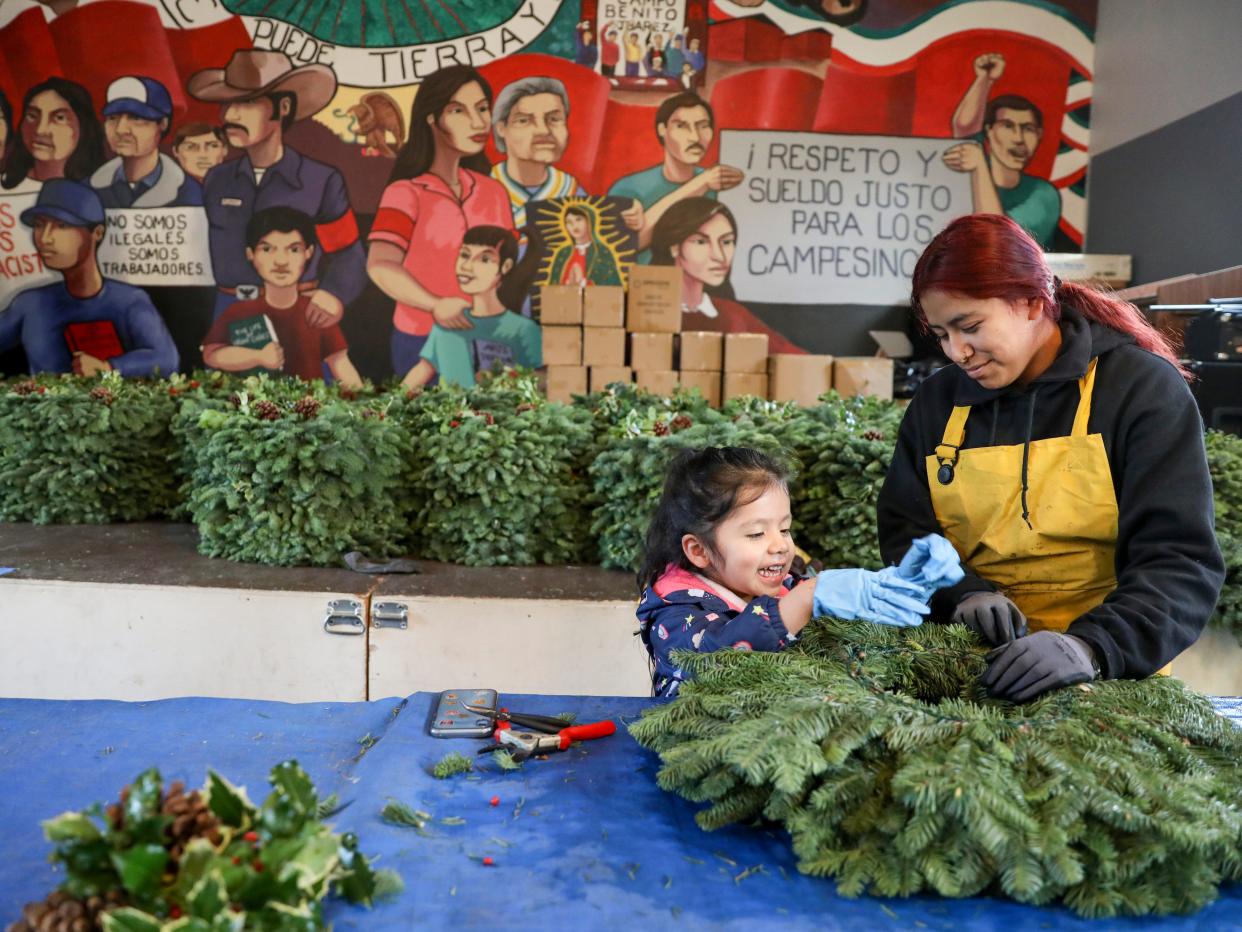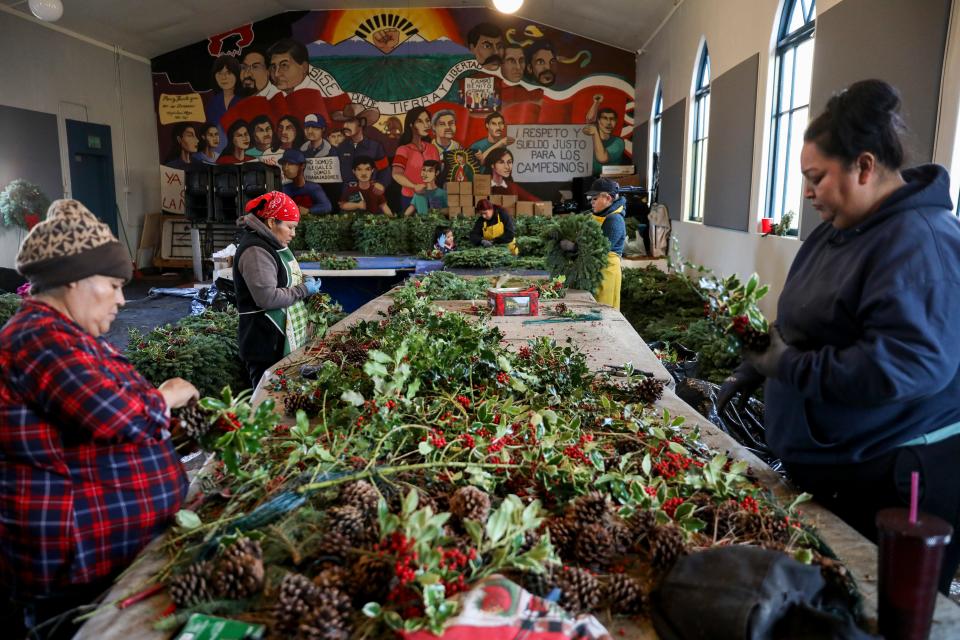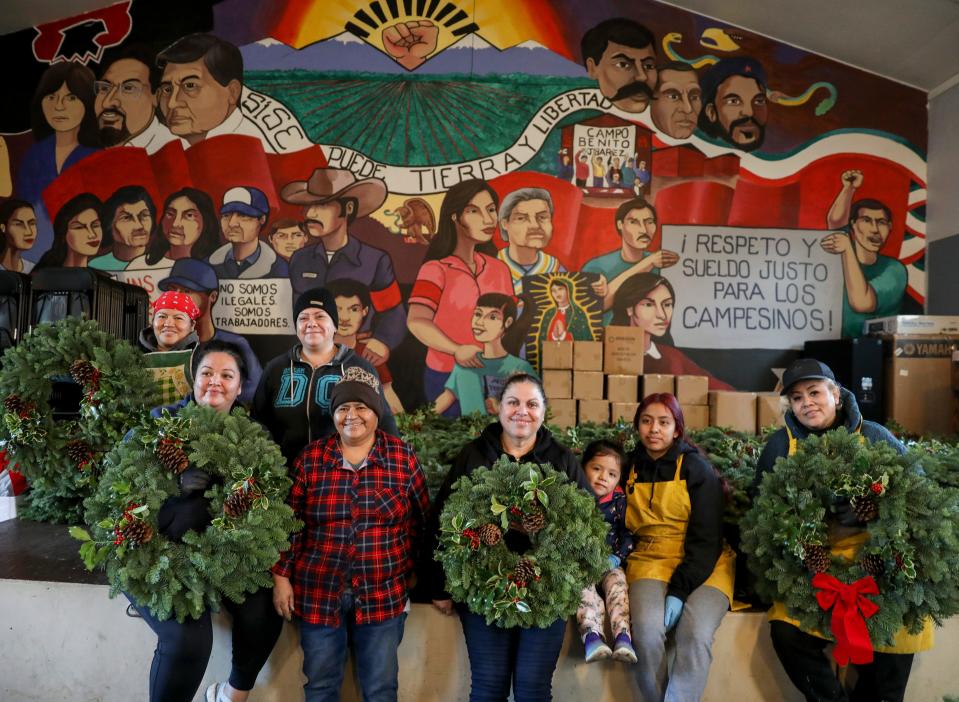For women farmworkers in Oregon, pathways to progress aren't always easy

Based on smell alone, you’d be forgiven for thinking the office building in downtown Woodburn was a satellite workshop for Santa himself.
For five weeks each winter, the smell of pine – or, more technically, Nobel fir – fills each nook and cranny of PCUN’s office. Follow it to the back room, an auditorium where the farmworker union usually hosts meetings and seminars for its members, and you’ll find the cause: hundreds of Christmas wreaths, crafted, by hand, by women who spend the rest of the year working on farms.
It is a workshop, of sorts. The wreath project started in 1992 by a group of women who came to PCUN’s office at Christmastime looking for work.
The holiday season is slow for farmworkers and financially difficult. Harvest is over. For many, there’s no work to be found, which means no money to be made.
The women of 1992 decided to make and sell wreaths out of Oregon’s infamous Christmas trees. The project that has endured 30 years has turned into both a holiday tradition and an important source of income. This year, they made 1,750 wreaths.
“It gives them a month’s worth of work and helps them and their families during this season,” said Rebeca Velasquez, director of Mujeres Luchadoras Progresistas (Women Striving for Progress).
Her program organizes the wreath drive every year. It started as an arm of PCUN but became its own nonprofit in 2001. Christmas is its busy season, but its mission is year-round: promoting economic development for farmworker women.
While pathways to professional development exist for farmworkers, women who work in the fields know their journeys are often harder than those of the men working next to them.
Moving up or moving out
Silvia Munoz had worked in the field for several years when she had a serious accident.
She doesn't remember how old she was, exactly, maybe 16 or 17. She was working in orchards in the Columbia River Gorge with her parents and fell from the 11th step of a 12-step ladder.
"I remember just sliding slowly; I heard a squeaky noise," she said. The noise was her ankle getting stuck in between the ladder's rungs.
Then she remembers her fellow crewmembers, almost all men, surrounding her, asking her if she was OK but mostly assuring her that she was fine.
"You're fine, get up," she remembers them telling her.
"My dad didn't even come help; he just kept working."
It was the beginning of the end of Munoz's career as a farmworker. Her mother said she didn't want Munoz to experience the same hardships she had. So Munoz finished high school and enrolled at community college. She became a client at Oregon Human Development Corporation (OHDC), a nonprofit dedicated to workforce development for farmworkers.
Now, Munoz is the director of the National Farmworker Jobs Program for OHDC, the very program that helped her jumpstart a career away from orchards and fields of her youth. The program is funded by the Department of Labor and administered locally by OHDC.
Her job is farm work-adjacent; she does a lot of direct outreach to workers in the field. But it's an office job.
That's a constant tension for women in farm work, she said: whether to move up through it, or leave it altogether. Indeed, most of the work she does with the National Farmworker Jobs Program is to help people find different work.
"When I used to work in the field, I noticed more women, specifically, who wanted to pursue something outside of agriculture," she said. "Men were the 'provider.' They knew they were good in the field. Women wanted more for themselves."
Farm work is demanding. It is physically strenuous, and its hours, especially during harvest seasons, are relentless. Many farmworkers' days begin before dawn and end after sunset.
For women, especially, that takes a toll, Munoz said.
"Many women who work in agriculture, that's not their only job," she said. "At the end of the day, they still have to go to their second job, which is being a caregiver. For a lot of women, that stops them from pursuing anything else."
Munoz said most women she works with at OHDC want to work in an office. OHDC's National Farmworker Jobs Program provides the resources and trainings they need to do that. The program offers GED classes, vocational training, English lessons, and job referrals. It also provides financial assistance to those who could not otherwise afford the time it takes to learn new skills,
She remembers one client, specifically, who entered the program with zero English-speaking ability.
"She couldn't even say 'hello,'" Munoz said. But she wanted to work in an office.
The client took English classes at Chemeketa Community College and on Rosetta Stone. She treated it like a "full-time job," Munoz said.
The program helped her secure an internship at a chiropractor's office. She worked there while continuing her English lessons. OHDC supported her financially the entire time.
Now, she manages the office.
Bigger ladders, harder climbs
There are ways to advance and earn more money in farm work.
Employees who start as field laborers can become field supervisors, crew leads, or farm managers. Tractor drivers and equipment operators often earn a higher hourly wage, according to data from the US Department of Agriculture, because the job requires specific training and knowledge. Workers with commercial drivers’ licenses (CDL) also make more money than field laborers.
But farm work is seasonally dependent. Workers follow the crops, and the money.
Such seasonality makes it hard to stay with one farm or one company for long, which might allow farmworkers to establish some permanence and power.
“Normally, you move around with different companies and seasons,” said Elia Cordero, a farmworker who helped make wreaths. “It’s really hard to stay at one place too long.”

Some farmworkers prefer to work for farm labor contractors, who find work for them year-round but also can leave workers vulnerable to exploitation.
Neither the USDA nor the US Department of Labor separates wage data by gender. Farmworkers make an average of $14.84 per hour, according to the Department of Labor. But supervisors, managers, and equipment operators can make up to a dollar more per hour. Most of those positions are filled by men.
Roughly 73% of farmworkers are men, according to data from USDA. And 87% of supervisors, inspectors, or managers are men. Just 13% of all leadership roles in agriculture are held by women.
In her 15 years working in the field, Munoz said she has only met one female supervisor.
“I remember her name, I remember her, specifically,” Munoz said. Everyone else – the tractor drivers, the crew leads, the people in charge – “were all men.”
Velasquez, too, said almost all of her bosses in farm work have been men.
Even in the fields, where wages are supposed to be equal, Munoz and Velazquez both said women often earn less money than their male counterparts.
“Women aren’t treated equally; we’re paid less,” Velasquez said.
Farmworkers are often paid by piece instead of by hour, meaning they are paid by how much they can produce or harvest. Berry and grape harvesters, for instance, are often paid by the bucket.
It’s a system that benefits physical fitness. Workers who can carry more weight and travel more quickly make more money.
“It’s really hard to do every day,” Cordero said.
Munoz saw first-hand that her mom often worked more slowly than her dad and made less money as a result. As an outreach worker at OHDC, she saw those patterns repeated.
“I had a lot of conversations about how women didn’t feel like they could earn an income because they weren’t fast enough, or the fruit was too heavy for them,” she said.
Single women have it even harder because they earn only as much as they can carry. They are often the ones Munoz sees in her office.
Couples and families, Munoz said, will sometimes pool their labor – one person picks, the other person collects and cashes in. In those cases, one person – usually the man – earns all the piece-rate wages for two people. But the other person, usually the woman, still earns minimum wage.
“Together, they [make] enough money to support themselves and their families,” Munoz said.
Munoz and Velasquez both said farmworker women also face harassment and discrimination more frequently than the men working beside them. Almost all women surveyed in a study by Human Rights Watch reported experiencing harassment or violence, often at the hands of their employers.
The cumulative effect of harassment, discrimination, lower wages, language barriers and extra domestic duties at home, is that women feel less empowered and less supported in agricultural work, Munoz said – and less able to advance in it.
“Women in agriculture are seen as underdogs,” Munoz said. “I know a lot of women who like the fields, like working in agriculture. But they are sometimes pushed out because they are not being supported.”

Fulfilling at its best
Velasquez still works in the fields sometimes, picking blueberries.
“It’s what I like to do,” she said.
Because when it is good, farm work is great, women agree. Even when it’s hard.
“It’s beautiful work,” Cordero said. “You enjoy it; enjoy being outside, laughing. You meet people you wouldn’t otherwise.”
Cordero has done it all. She started picking peppers – hard, ugly work, she said. But she found her groove, and she said she has been fortunate to find companies that support her.
In 20 years of farm work, Cordero said she has driven tractors and forklifts, managed teams, worked for labor contractors that paid her fair wages.
“When you have the confidence and the opportunity, it pays off,” Cordero said.
Munoz said the first step toward professional advancement for farmworker women is just acknowledging their place and value in the workforce.
“I remember someone telling me once that when they think of farmworkers, they think of men,” Munoz said. “But there’s a lot of women in there, actually.”
Recognizing women means recognizing the barriers they face, and working to dismantle them, Munoz said.
“We just really need to think about being more inclusive of women,” she said.
Women like Cordero, who loves her job, wouldn’t trade it for anything.
“Working in the field has been one of the greatest experiences of my life,” Cordero said.
A Christmas tradition
On a recent snowy afternoon, Cordero stood across a table from sisters Angela and Francisca Gaspar as they decorated Nobel fir Christmas wreaths with holly and tinsel.
The youngest Gaspar, 4-year-old Zulema, had already had made her own small wreath. Her cousin, 18-year-old Jessica Dirzio Ramirez started making wreaths at around the same age. Ramirez helped her young cousin, taught her everything she knows about crafting wreaths by hand.
Wreath-making has become a holiday tradition, Velasquez said. A way to survive an otherwise difficult time of year, but also a way for women to come together.
The wreaths don’t make much money for Mujeres Luchadoras Progresistas. At $40 a piece – they had to raise the price this year for the first time in a decade – they make enough for the women to take home to their families.
But each person who adorns their home with a wreath from MLP this year can feel good about their decoration, the women agreed. Good about the fact that it was crafted by hand, by women who spend the rest of their year working to put food on strangers’ tables.
“All of the families that are buying our wreaths, they’re happy to be buying them from us,” Francisca Gaspar said. “And on Christmas, they’ll think of us.
Shannon Sollitt covers agricultural workers through Report for America, a program that aims to support local journalism and democracy by reporting on under-covered issues and communities. Send tips, questions and comments to ssollitt@statesmanjournal.com
This article originally appeared on Salem Statesman Journal: Women farmworkers face harder path to professional development
